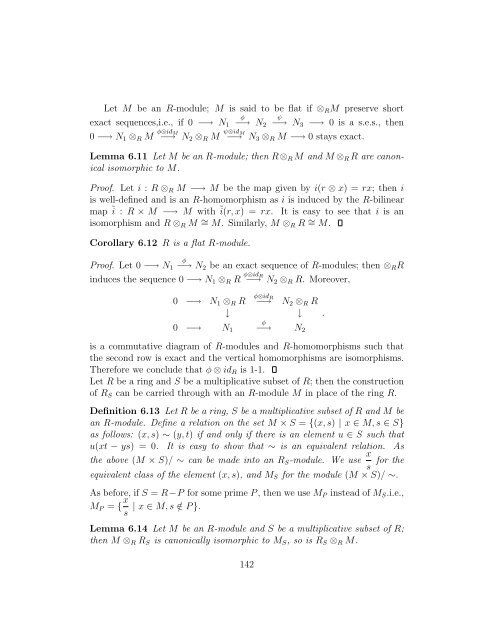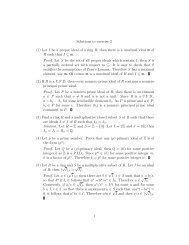Topics in algebra Chapter IV: Commutative rings and modules I - 1
Topics in algebra Chapter IV: Commutative rings and modules I - 1
Topics in algebra Chapter IV: Commutative rings and modules I - 1
Create successful ePaper yourself
Turn your PDF publications into a flip-book with our unique Google optimized e-Paper software.
Let M be an R-module; M is said to be flat if ⊗RM preserve short<br />
exact sequences,i.e., if 0 −→ N1<br />
φ<br />
−→ N2<br />
ψ<br />
−→ N3 −→ 0 is a s.e.s., then<br />
0 −→ N1 ⊗R M φ⊗idM<br />
−→ N2 ⊗R M ψ⊗idM<br />
−→ N3 ⊗R M −→ 0 stays exact.<br />
Lemma 6.11 Let M be an R-module; then R⊗R M <strong>and</strong> M ⊗R R are canonical<br />
isomorphic to M.<br />
Proof. Let i : R ⊗R M −→ M be the map given by i(r ⊗ x) = rx; then i<br />
is well-def<strong>in</strong>ed <strong>and</strong> is an R-homomorphism as i is <strong>in</strong>duced by the R-bil<strong>in</strong>ear<br />
map ĩ : R × M −→ M with ĩ(r, x) = rx. It is easy to see that i is an<br />
isomorphism <strong>and</strong> R ⊗R M ∼ = M. Similarly, M ⊗R R ∼ = M.<br />
Corollary 6.12 R is a flat R-module.<br />
φ<br />
Proof. Let 0 −→ N1 −→ N2 be an exact sequence of R-<strong>modules</strong>; then ⊗RR<br />
<strong>in</strong>duces the sequence 0 −→ N1 ⊗R R φ⊗idR<br />
−→ N2 ⊗R R. Moreover,<br />
0 −→ N1 ⊗R R φ⊗idR<br />
−→ N2 ⊗R R<br />
↓ ↓<br />
0 −→ N1<br />
φ<br />
−→ N2<br />
is a commutative diagram of R-<strong>modules</strong> <strong>and</strong> R-homomorphisms such that<br />
the second row is exact <strong>and</strong> the vertical homomorphisms are isomorphisms.<br />
Therefore we conclude that φ ⊗ idR is 1-1.<br />
Let R be a r<strong>in</strong>g <strong>and</strong> S be a multiplicative subset of R; then the construction<br />
of RS can be carried through with an R-module M <strong>in</strong> place of the r<strong>in</strong>g R.<br />
Def<strong>in</strong>ition 6.13 Let R be a r<strong>in</strong>g, S be a multiplicative subset of R <strong>and</strong> M be<br />
an R-module. Def<strong>in</strong>e a relation on the set M × S = {(x, s) | x ∈ M, s ∈ S}<br />
as follows: (x, s) ∼ (y, t) if <strong>and</strong> only if there is an element u ∈ S such that<br />
u(xt − ys) = 0. It is easy to show that ∼ is an equivalent relation. As<br />
the above (M × S)/ ∼ can be made <strong>in</strong>to an RS-module. We use x<br />
for the<br />
s<br />
equivalent class of the element (x, s), <strong>and</strong> MS for the module (M × S)/ ∼.<br />
As before, if S = R−P for some prime P , then we use MP <strong>in</strong>stead of MS.i.e.,<br />
MP = { x<br />
| x ∈ M, s /∈ P }.<br />
s<br />
Lemma 6.14 Let M be an R-module <strong>and</strong> S be a multiplicative subset of R;<br />
then M ⊗R RS is canonically isomorphic to MS, so is RS ⊗R M.<br />
142<br />
.



